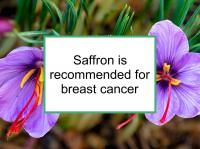Saffron (Crocus sativus) contains bioactive compounds that are responsible for its color, flavor and aroma. These include various crocins, as well as beta-carotene, kaempferol, lycopene, zeaxanthin, and safranal (a derivative of zeaxanthin which is the main aroma component of saffron's fragrant essential oil).
Saffron components have been shown to have strong antioxidant, anti-inflammatory, neuroprotective, radioprotective, anti-carcinogenic and anti-tumor properties, as well as reducing blood pressure, anxiety and depression.
Both saffron extract and crocin (a carotenoid) have been found to suppress DNA damage in a dose dependent manner in the livers, lungs, kidneys, and spleens of laboratory mice. Saffron has been shown to inhibit carcinogen-induced skin carcinoma in mice and to have cytotoxic action against human leukemia cell lines. Saffron also has been shown to cause cell death in HeLa and HepG2 liver cancer cells and TCC 5637 transitional cell carcinoma cells. Saffron extract and its constituent, crocin, have been shown to significantly inhibit the growth of colorectal cancer cells while not harming normal cells. Crocetin, another saffron carotenoid, has been shown to have significant antiproliferative and proapoptic effects in pancreatic cancer cells in the laboratory and in laboratory mice.
Breast cancer-related effects of eating saffron
Saffron inhibits breast cancer
Saffron and its components have been shown to have dose-dependent inhibitory effects on the proliferation of hormone receptor positive (ER+/PR+), HER2-positive (HER2+) and triple negative (ER-/PR-/HER2-) breast cancer cells. Saffron has also been shown to reduce angiogenesis (new blood vessel formation) in ER+/PR+ breast cancer cells.
Saffron can enhance some breast cancer treatments
Extracts of saffron have been shown to considerably increase the cytotoxicity in breast cancer cells induced by doxorubicin and paclitaxel. At the same time, saffron has been found to greatly inhibit cellular DNA damage, including doxorubicin-induced heart and kidney damage.
Saffron has also been shown to enhance the treatment effects of radiotherapy.
Avoided saffron during chemotherapy incorporating cyclophosphamide
One study reported that concurrent use of cyclophosphamide and saffron extract reduced the toxic effect of cyclophosphamide and caused estrogen to be produced.
Additional comments
There is some evidence that saffron could be toxic at very high doses. Saffron should be consumed as a spice and not in the form of a supplement.
Saffron is hand picked and hand processed, which is one reason for its high market price. Saffron is grown primarily in Iran, but it is also grown in Spain, Portugal, Italy, Kashmir and some parts of North Africa. Much of the Iranian production is redistributed through Spain. Saffron grown in these regions generally is grown without using pesticides. China is also beginning to produce saffron.
Meadow saffron should be avoided
Meadow saffron (Colchicum autumnale), also known as wild saffron, autumn crocus, or colchicum, is an unrelated and poisonous plant that should not be confused with saffron and is to be avoided. It can cause thirst, pain, diarrhea, weakness, vomiting, kidney failure, coma, and death from respiratory failure. Diluted fractions of meadow saffron are sometimes used in herbal remedies for gout and arthritis.
Sources of information in this webpage
The information above, which is updated continually as new research becomes available, has been developed based solely on the results of academic studies. Clicking on any of the underlined terms will take you to its tag or webpage, which contain more extensive information.
Below are links to 20 recent studies concerning this food and its main components. For a more complete list of studies, please click on saffron.
